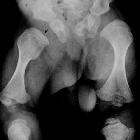Kummel disease

Gaseinschlüsse
im Wirbelkörper als Zeichen einer Osteonekrose des Wirbels im Rahmen einer Fraktur. Typische bandförmige Konfiguration des Gases. Der Pfeil weist auf eine Frakturlinie auch im Dornfortsatz hin, was die Schwere des Traumas unterstreicht. Computertomographie sagittal rekonstruiert.

Gaseinschlüsse
im Wirbelkörper als Zeichen einer Osteonekrose des Wirbels im Rahmen einer Fraktur bei einem 85 jährigen Mann. Typische bandförmige Konfiguration des Gases. Computertomographie links axial, Mitte coronar, links sagittal im Knochenfenster.

Vakuumphänomen
in eingebrochenem Wirbelkörper, dringend verdächtig für Wirbelkörpernekrose.

Gaseinschlüsse
(signallos) im Wirbelkörper als Zeichen einer Osteonekrose des Wirbels im Rahmen einer Fraktur. Bestätigung im CT. Typische bandförmige Konfiguration des Gases. Magnetresonanztomographie T1 sagittal.

Gaseinschlüsse
(signallos) im Wirbelkörper als Zeichen einer Osteonekrose des Wirbels im Rahmen einer Fraktur. Bestätigung im CT. Typische bandförmige Konfiguration des Gases. Magnetresonanztomographie T2 sagittal.

Gaseinschlüsse
(signallos) im Wirbelkörper als Zeichen einer Osteonekrose des Wirbels im Rahmen einer Fraktur. Bestätigung im CT. Typische bandförmige Konfiguration des Gases. Magnetresonanztomographie STIR sagittal.

Große
Flüssigkeitsansammlungen (Blut!?) und Gaseinschlüsse (diese besser im CT zu identifizieren) im Wirbelkörper als Zeichen einer Osteonekrose des Wirbels im Rahmen einer Fraktur bei einem 85 jährigen Mann. Typische bandförmige Konfiguration. Magnetresonanztomographie links axial T2, dann sagittal T1, T2 und STIR.

Kümmell
disease • Kümmell disease - Ganzer Fall bei Radiopaedia

Kümmell
disease • Vertebral body avascular necrosis (annotated) - Ganzer Fall bei Radiopaedia

Osteonecrosis
• Vertebral body avascular necrosis - Ganzer Fall bei Radiopaedia

Kümmell
disease • Kümmell disease (avascular necrosis of the vertebrae) - Ganzer Fall bei Radiopaedia

Kümmell
disease • Kümmell disease - Ganzer Fall bei Radiopaedia

Kümmell
disease • Kümmell disease - Ganzer Fall bei Radiopaedia

Kümmell
disease • Kümmell disease - Ganzer Fall bei Radiopaedia

Osteonecrosis
• Kümmell disease - Ganzer Fall bei Radiopaedia
Kümmell disease is an eponymous name for osteonecrosis and collapse of a vertebral body.
Pathology
Kümmell disease represents delayed (usually two weeks) vertebral body collapse due to ischemia and non-union of anterior vertebral body wedge fractures after major trauma.
Risk factors
Risk factors include:
- osteoporosis
- corticosteroid use
- alcoholism
- radiation therapy
Radiographic features
Plain radiograph / CT
- shows collapse of affected vertebrae (typically lower thoracic and upper lumbar)
- an intravertebral vacuum cleft and fluid may be seen (accentuated on extension stress lateral views), although this is non-specific
MRI
- the intravertebral vacuum cleft is usually seen as low signal intensity with all sequences
- if intravertebral fluid is present it is low T1 signal and high T2 signal
The severity of the vertebral collapse has been found to be higher in those who have intravertebral gas compared to those who only have intravertebral fluid, signifying that the presence of intravertebral gas is possibly a more advanced stage of the disease .
History and etymology
This condition was first described by Hermann Kümmell (1852-1937), a German surgeon, in 1891 .
Siehe auch:
- Vakuumphänomen im Wirbelkörper
- Hämangiom der Wirbelsäule
- Osteomyelitis
- Aseptische Knochennekrose
- Osteogenesis imperfecta
- Platyspondylie
- vertebrale Metastasen
- Achondroplasie
- Multiples Myelom
- Osteoporose
- idiopathische kindliche Hüftkopfnekrose
- Spondyloepiphysäre Dysplasie
- Thanatophore Dysplasie
- Roberts-Syndrom
- Morbus Gaucher
- skeletale Manifestationen der Langerhanszell-Histiozytose
- Hypophosphatasie
- Kniest-Syndrom
- Stickler-Syndrom
- Hypothyreose
- Mukopolysaccharidose Typ IV
- Dysosteosklerose
- Metatrophe Dysplasie
- Spondylometaphysäre Dysplasie
- Spondyloepimetaphysäre Dysplasie
- Homozystinurie
- Dyggve-Melchior-Clausen-Syndrom
- Dreyfus-Syndrom
- Kongenitales Cushing-Syndrom
- Polytope Dysostose
und weiter:

 Assoziationen und Differentialdiagnosen zu Aseptische Wirbelkörpernekrose:
Assoziationen und Differentialdiagnosen zu Aseptische Wirbelkörpernekrose:skeletale
Manifestationen der Langerhanszell-Histiozytose



















